Whether you crave a discreet vent that vanishes behind cabinet panels or a hand-hammered copper showpiece that ages like fine wine, the 2025 kitchen places the range hood squarely in the spotlight. Designers are experimenting with bold colors, rich textures, concealed tech, and sculptural forms that double as art while still whisking away smoke and grease. Drawing on expert guides and trend reports, the twenty ideas below span classic farmhouse timber builds to ultramodern flush-ceiling units, offering fresh inspiration for every budget, layout, and cooking style.
1. Stainless Steel Range Hood Statement

A gleaming stainless steel range hood remains the go-to choice for cooks who want pro-kitchen performance and a timeless aesthetic. Architectural Digest notes that brushed or polished steel pairs easily with every cabinet color while reflecting light to make a small room feel larger, giving it “instant culinary-school credibility.” Interior appliance reviewers add that a 600-CFM steel hood provides enough airflow to clear searing steaks without deafening fans, especially when fitted with multi-speed controls and baffle filters recommended by Food & Wine’s equipment experts. For extra drama, run the steel chimney all the way to a 10-foot ceiling and flank it with open wood shelves to emphasize vertical lines and shine.
2. Copper Range Hood with Natural Patina
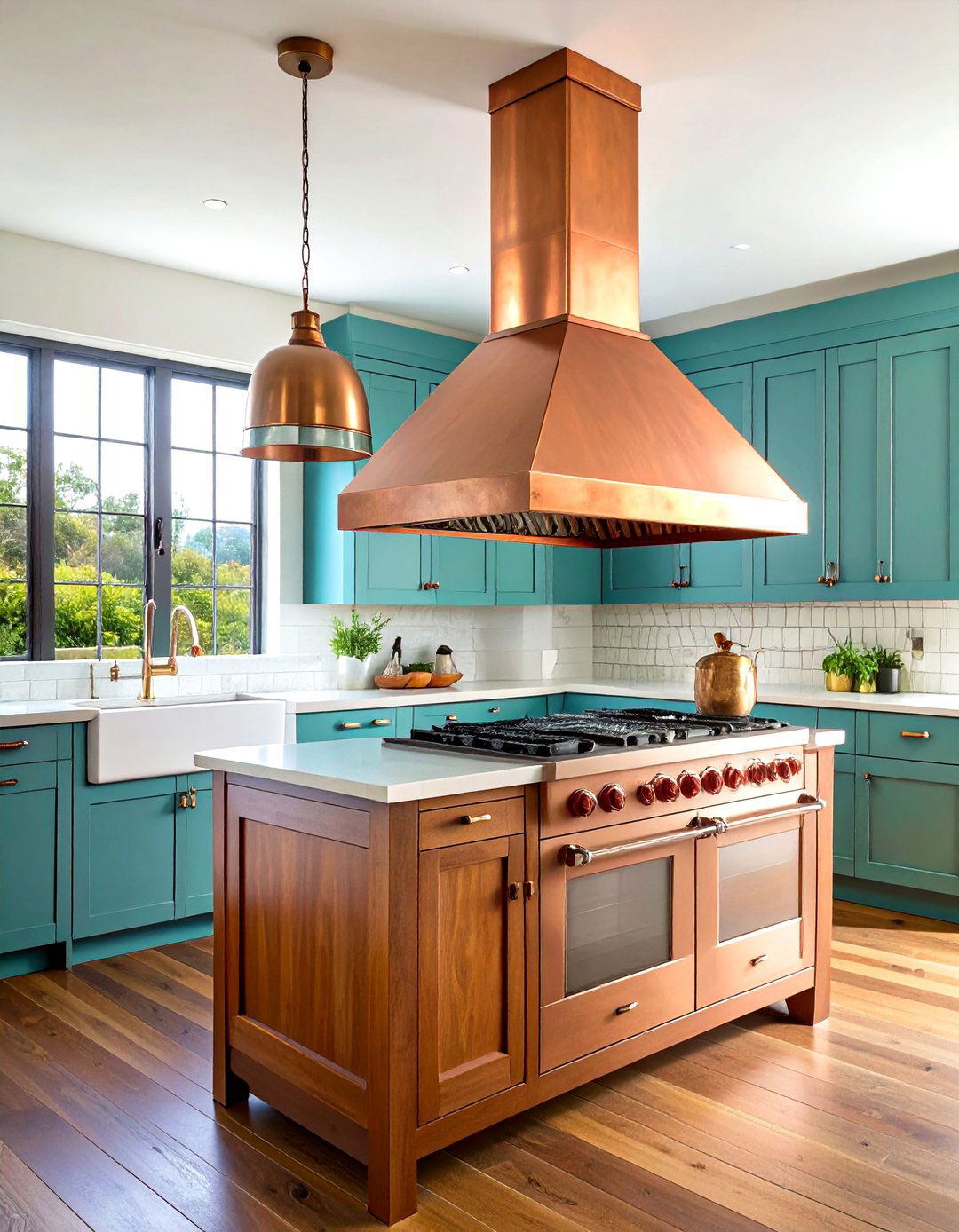
Unlike ubiquitous stainless, a hand-hammered copper range hood brings living color to the kitchen as its surface slowly darkens and blooms with turquoise streaks. CopperSmith’s guide explains that copper is naturally antimicrobial and develops a protective patina that owners prize for its artistry as well as its easy maintenance. RangeCraft adds that factory-applied lacquer lets you control that aging—leave it raw for drama or seal it for enduring penny-bright shine. Pairing copper with matte black hardware and butcher-block counters amplifies the warm metal tones, while a simple pyramidal shape keeps the look from tipping into historical pastiche.
3. Brass-Strapped Wood Range Hood
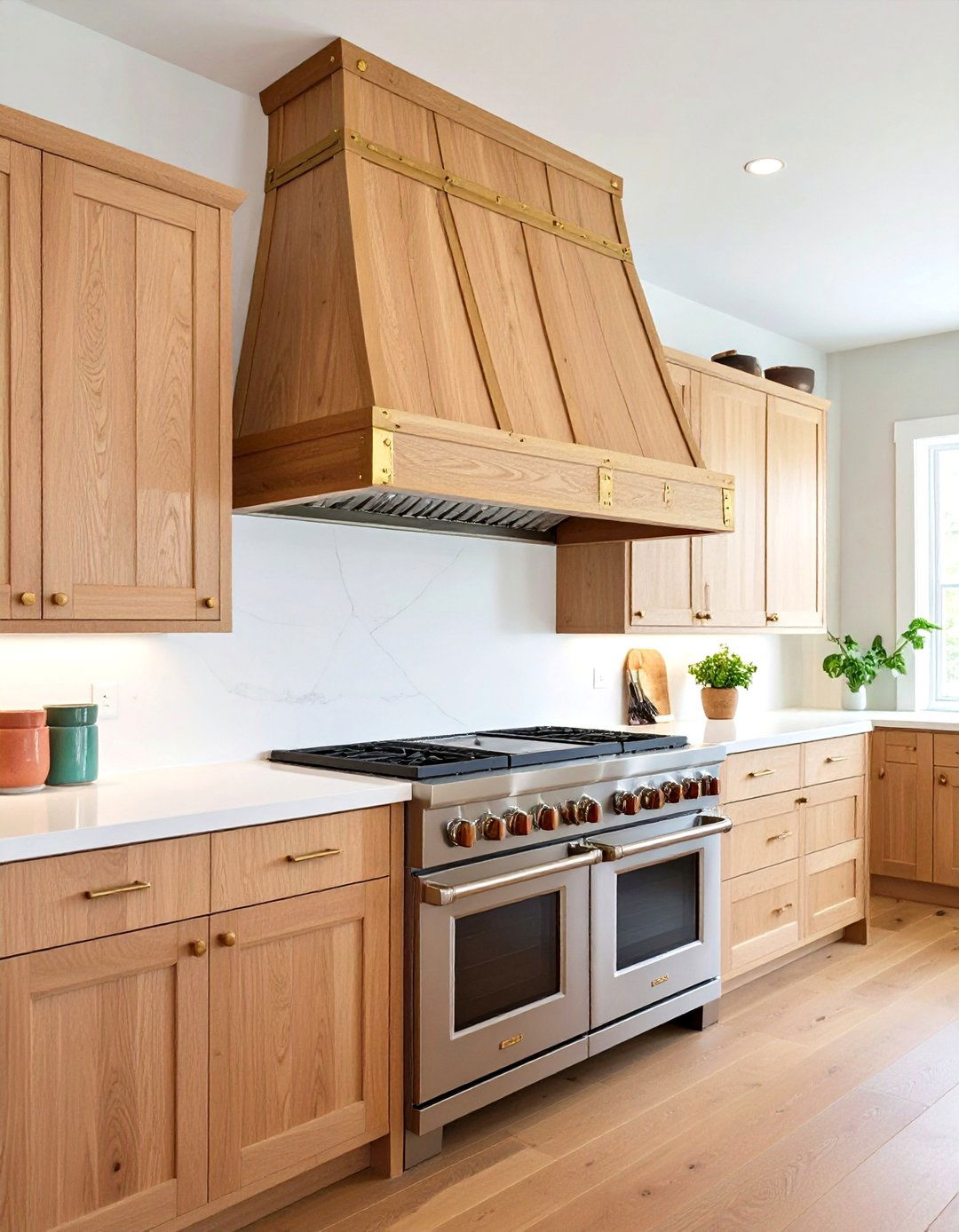
The warmth of painted or natural wood becomes gallery-worthy when edged with gleaming brass straps and rivets. Laura U Design says a single polished band catches light and echoes other brass accents, turning the vent into jewellery for the room without overwhelming subtle cabinetry. Designers often select white oak or maple for the body, then stain it a few tones darker than the upper cabinets to introduce quiet contrast. Add integrated LED strip lighting beneath the hood shelf to let the brass glow after dark, and tie the metal back in through knobs or a brass pot filler for a cohesive hardware story.
4. Plaster Range Hood with Wood Trim
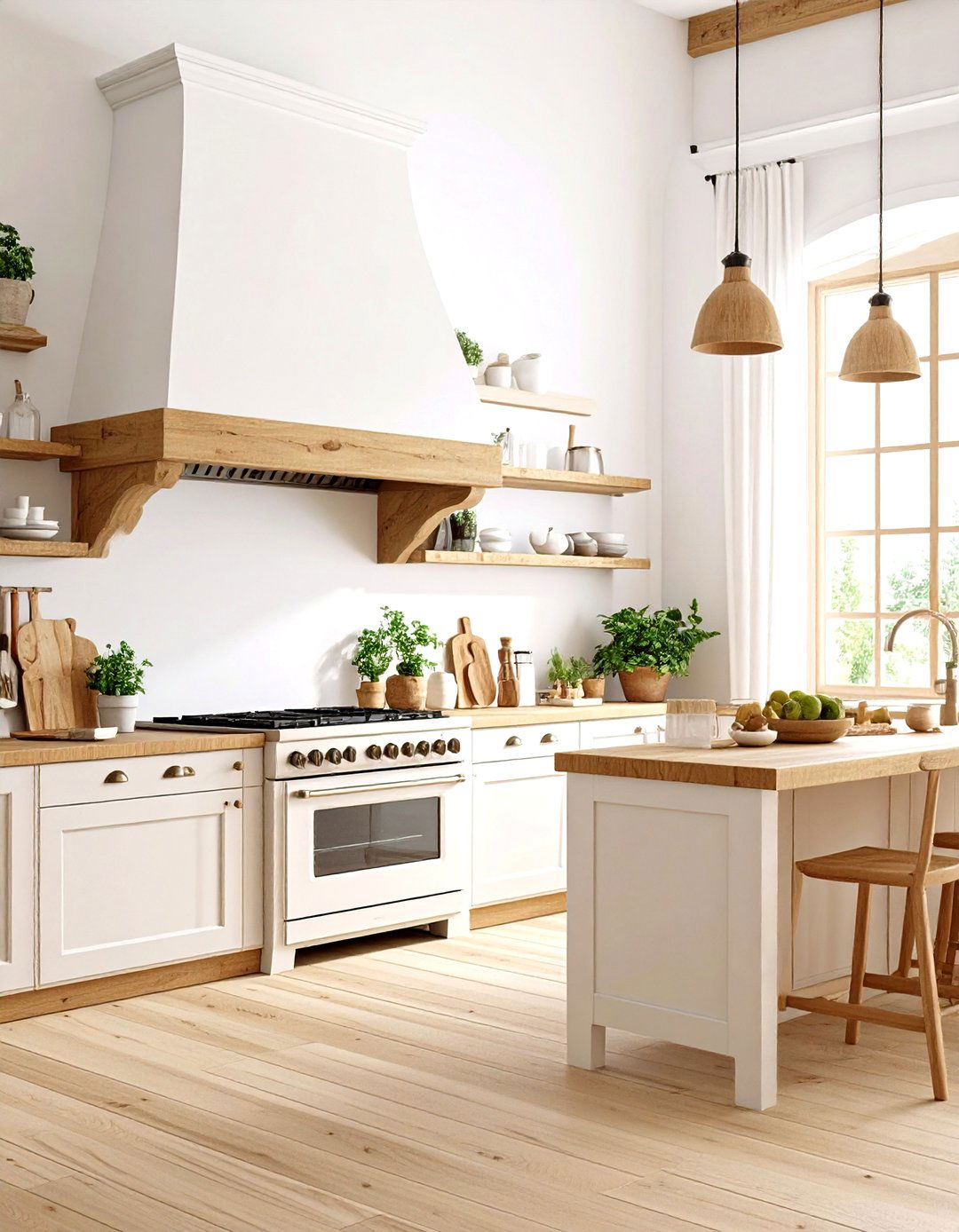
For lovers of Mediterranean texture, a smooth hand-troweled plaster range hood trimmed in slim oak rails offers sculptural elegance without visual heaviness. Pinterest boards devoted to this look show how off-white lime plaster reflects ambient light and blends seamlessly into matching walls, creating a monolithic canopy over the cooktop. Architects often wrap the base in two-inch natural oak or walnut, repeating the wood species used on floating shelves so the vent feels intentional, not added after the fact. Balance the organic plaster with matte-black sconces and pale stone counters for a modern yet softly rustic atmosphere, perfect for serious entertainers.
5. Concealed Panel-Ready Range Hood
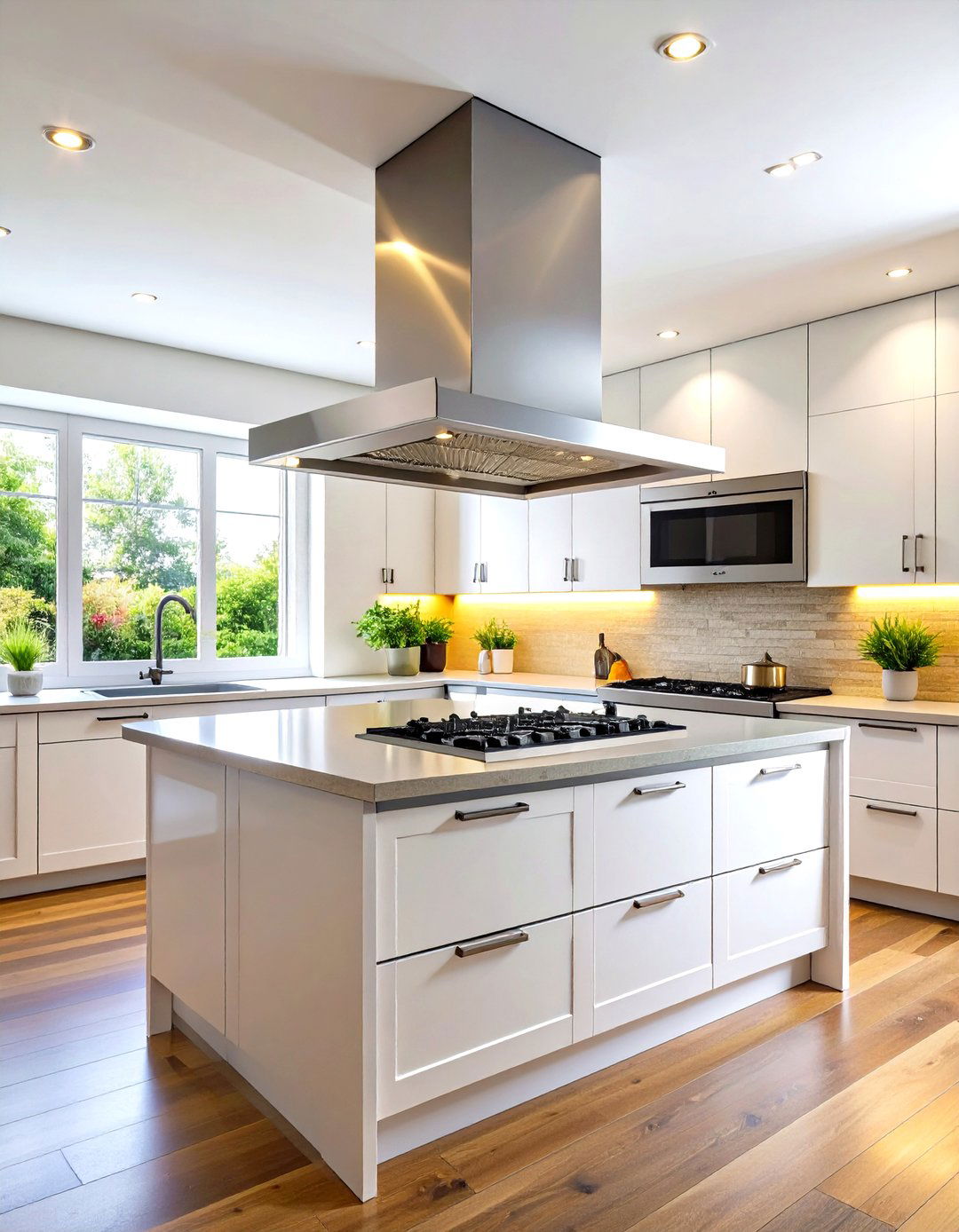
By cladding the vent insert with a cabinet-matching panel, homeowners achieve the seamless lines beloved in today’s quiet-luxury kitchens. Hauslane’s 2025 trend report points out that panel-ready appliances visually disappear, letting statement surfaces such as marble slabs take center stage. Designer Appliances lists dozens of inserts that accept custom panels while still delivering 400-plus CFM performance, so you sacrifice nothing in function. Continue the illusion by lining the hood bottom in the same wood veneer and adding touch-to-open controls hidden inside the trim rail. The result is an almost invisible vent—until you turn on the fan and lights.
6. Colored Enamel Range Hood Pop
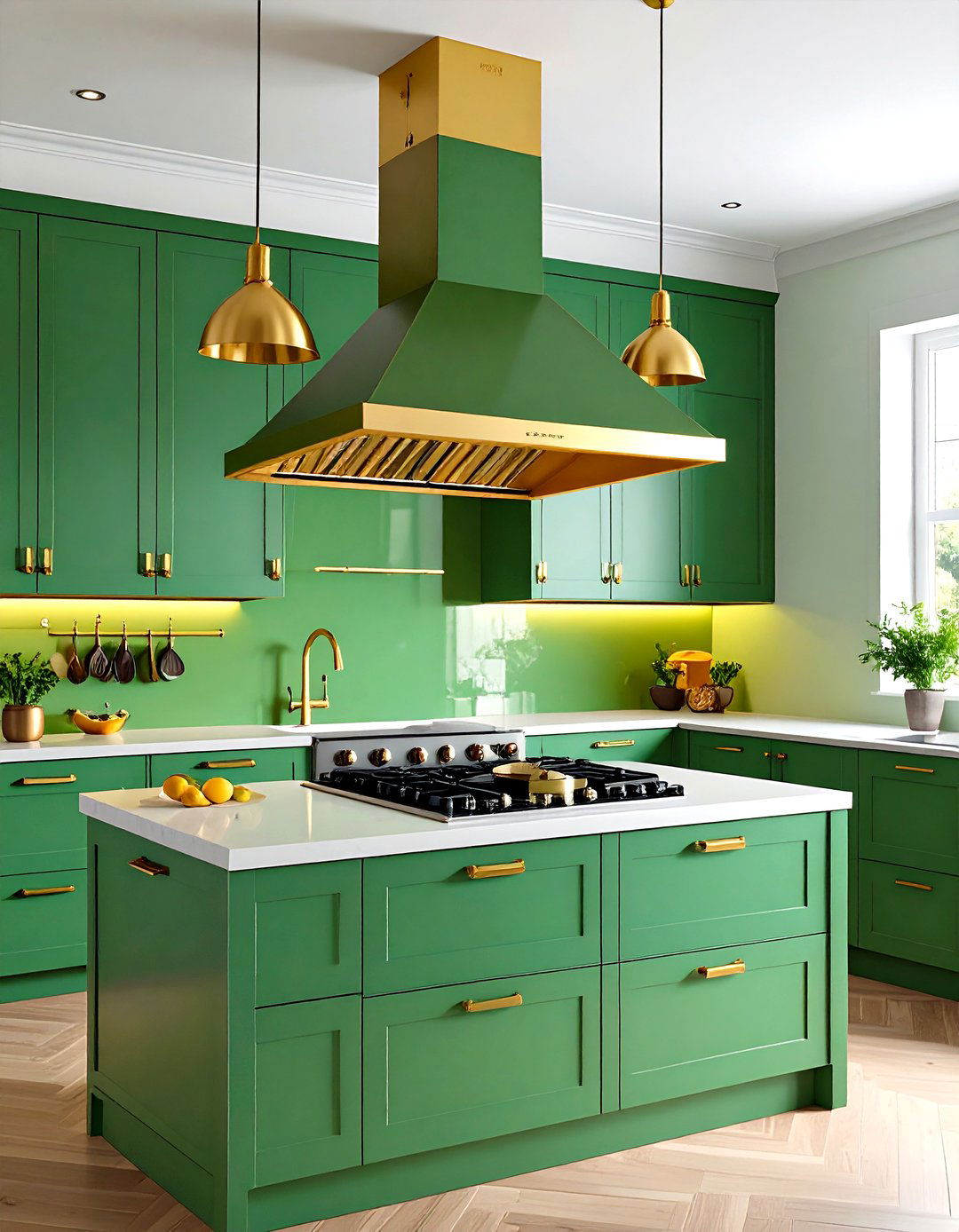
Take a cue from bold kitchen trendsetters and coat your range hood in saturated enamel—forest green, deep cranberry, or even matte robin’s-egg blue. Woodbury Magazine reports that designers increasingly treat the hood like a canvas for color, replacing formerly camouflaged vents with vibrant focal points that wake up neutral cabinetry. The Kitchn adds that unexpected shapes make the color pop even more: think tapered sides or an exaggerated curved skirt. To keep the look refined, repeat the hue only once more—perhaps on a single island stool—then ground everything with warm brass or stainless straps for continuous design harmony.
7. Glass Canopy Range Hood
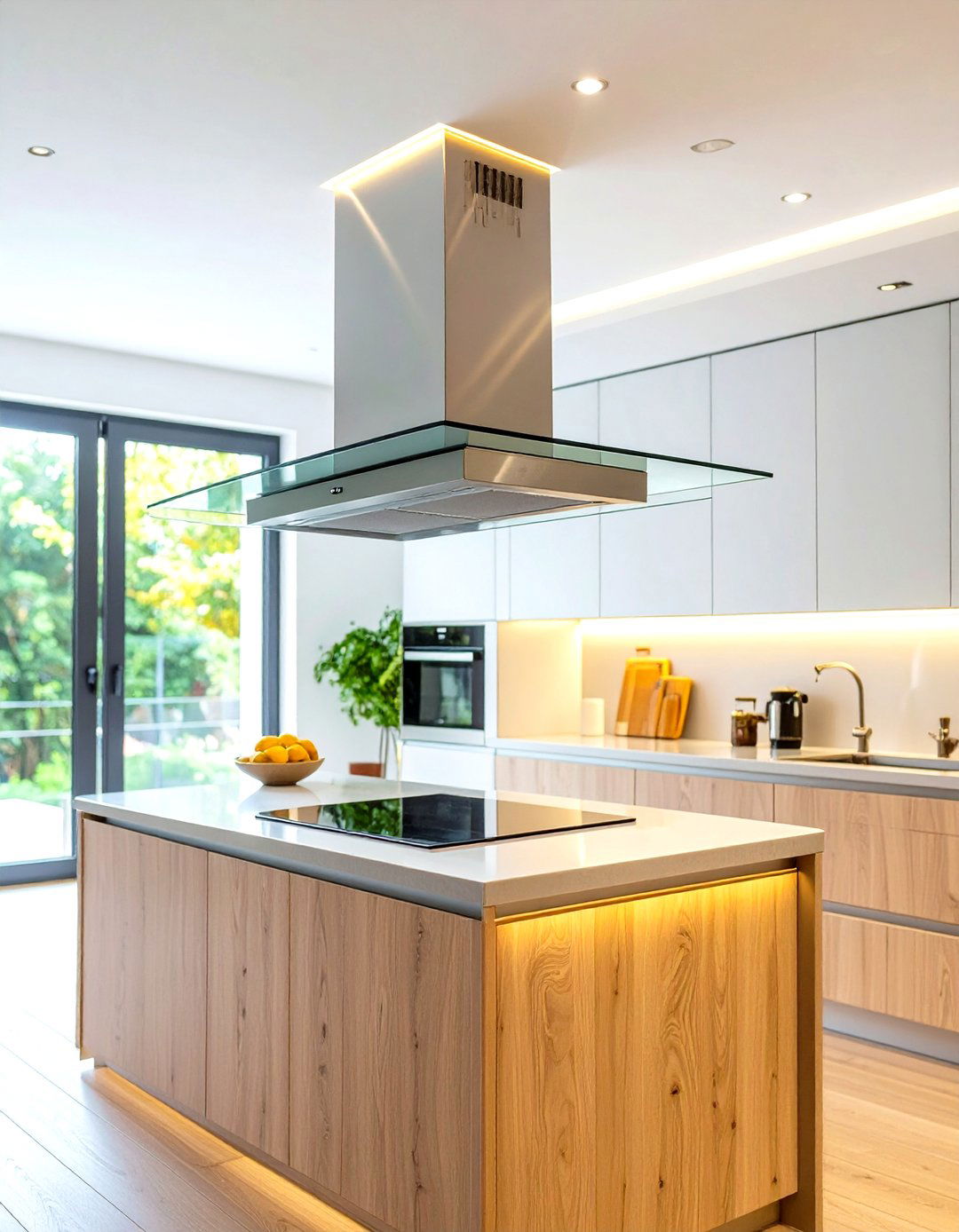
With its transparent sweep of tempered glass, a canopy range hood brings an airy, almost floating quality to compact kitchens. The Range Hood Store describes these models as blending effortlessly with any palette while channeling steam through a slim stainless spine. Futuro Futuro echoes that sentiment, noting that edge-lit LED panels along the glass underside can double as ambient task lighting after dusk. To keep fingerprints at bay, specify low-iron, anti-smudge glass and pair with streamlined chrome pot rails. The result is a vent that recedes visually yet still feels futuristic and upscale, even in small city flats.
8. Ceiling-Mounted Flush Range Hood
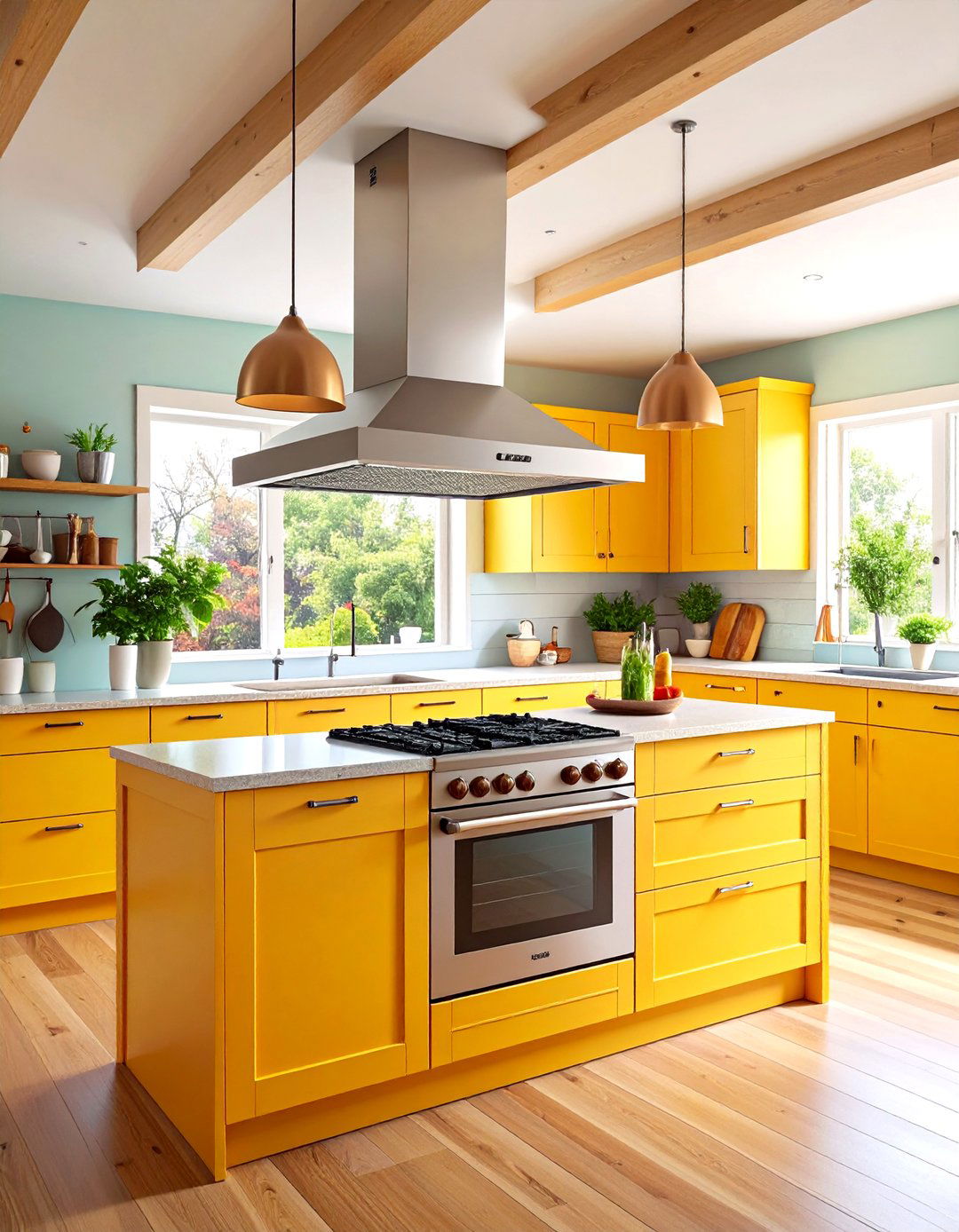
Owing to open-plan cooking spaces, many homeowners want ventilation that captures smoke without obstructing sight-lines to living areas, and a flush ceiling-mount hood delivers exactly that. Victory’s Sunset model nestles between standard joists, hiding its stainless body above the drywall so only a sleek grille remains visible. The Range Hood Store explains that remote blower motors keep noise levels down while maintaining 600-plus CFM, making conversation around the island effortless. Install a wall-switch dimmer for the built-in LED panel and match the ceiling paint for near invisibility, preserving a minimalist loft vibe even during smoky stir-fries at parties.
9. Downdraft Vent System Alternative
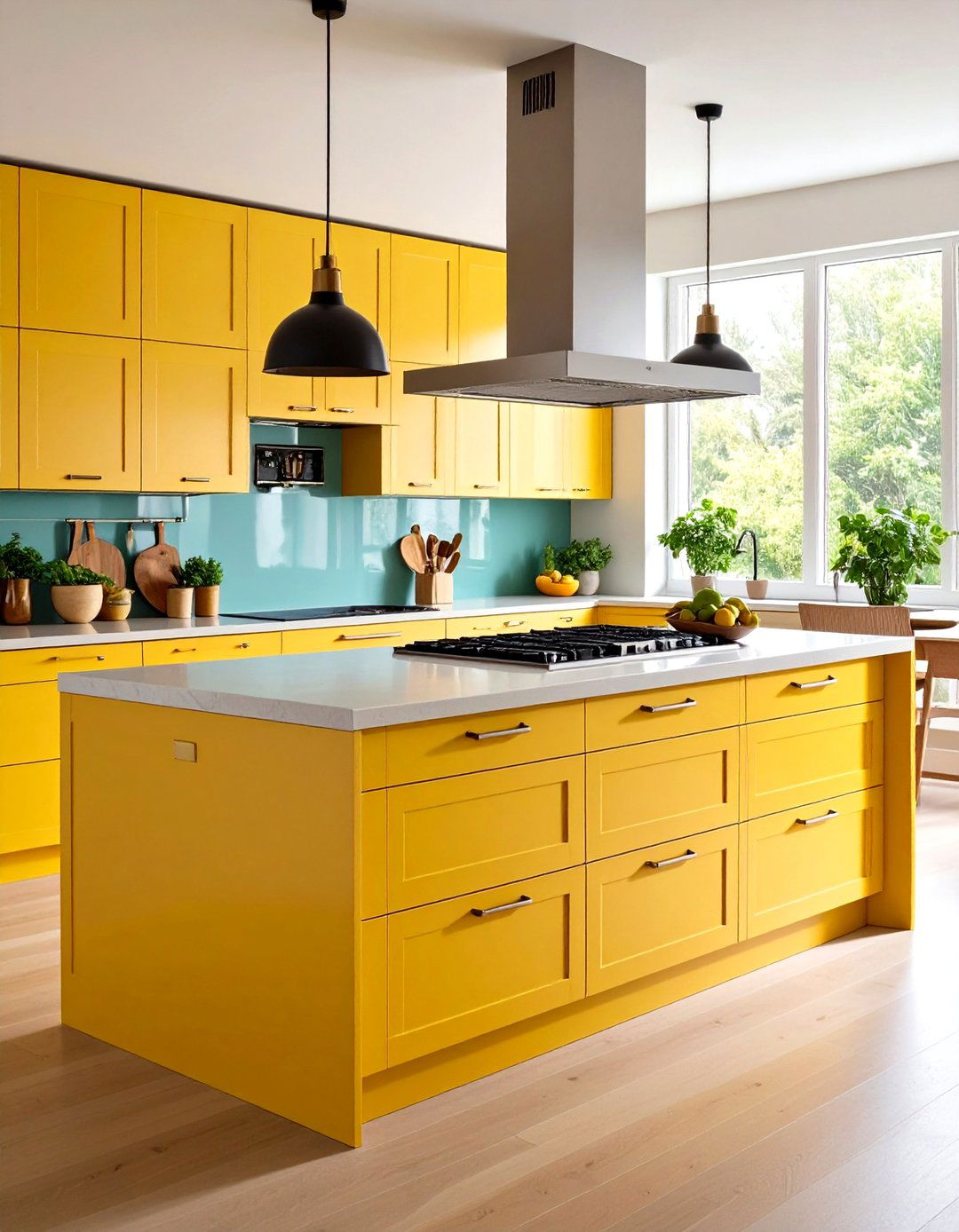
Despite looking nothing like a traditional chimney, a pop-up downdraft vent behind a cooktop can be a game-changer for island layouts. Whirlpool’s comparison guide notes that these units draw fumes sideways and downward, freeing the ceiling for pendants or skylights. Home-builders on Reddit caution that performance drops with tall pots, yet agree that pairing a downdraft with induction reduces steam plume height and improves capture. Keep duct runs short and include a make-up air damper to maximize efficiency. This stealthy option suits minimalist spaces where a bulky hood would disrupt sight-lines or clash with sculptural pendant lights overhead.
10. Arched Stone Range Hood
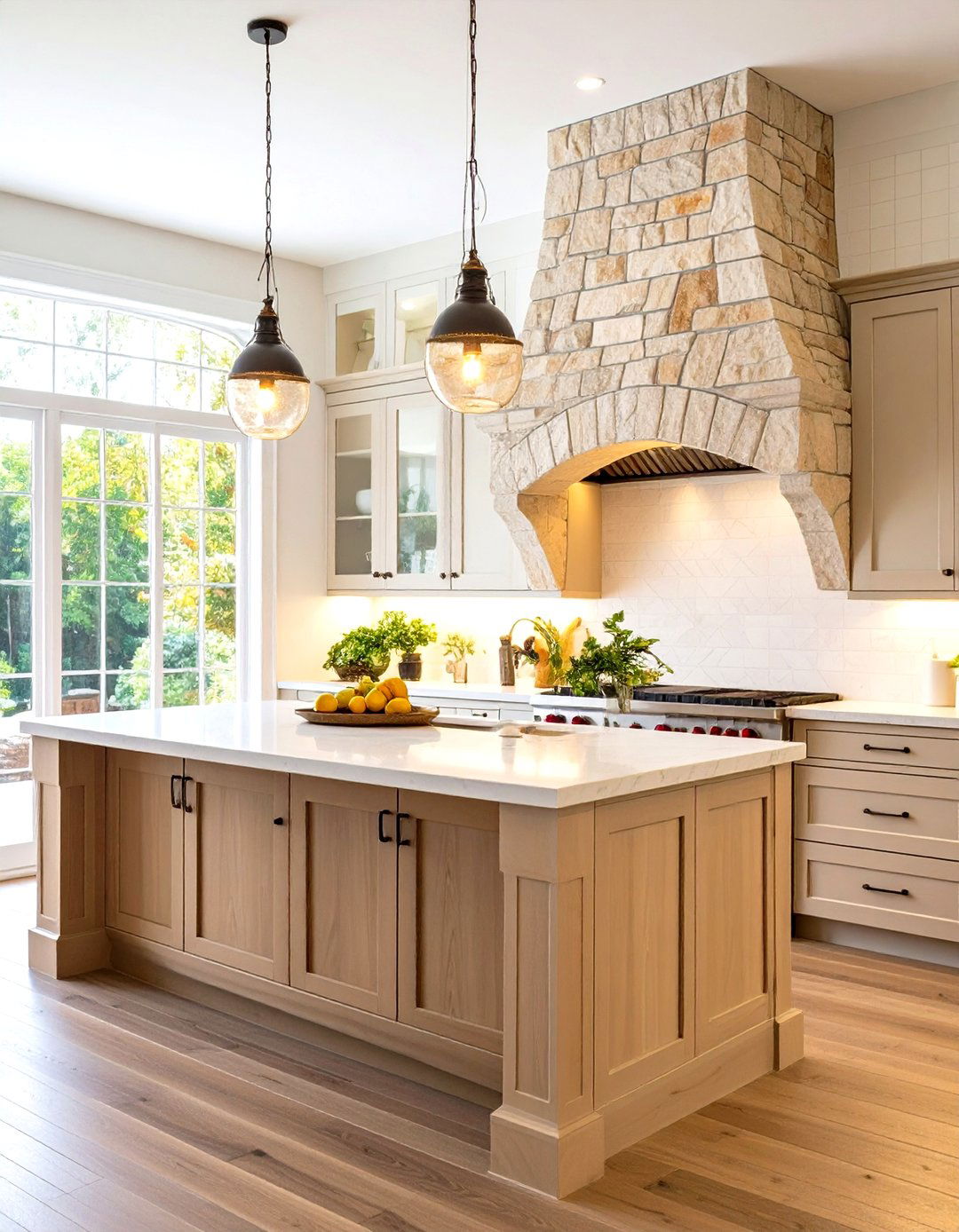
Consider carving the vent into an arched stone surround for an Old-World hearth effect that still hides a high-power insert. Architectural Digest highlights kitchens where a limestone arch frames the cooktop, visually linking the hood to stone counters while softening sharp cabinet lines. Tuck LED tape under the arch apex to graze the texture and ensure task lighting. Because stone adds weight, install a steel support angle tied into studs before setting veneer pieces, and specify a 1200-CFM remote blower so cooking odors don’t linger beneath the arch’s curve. This timeless focal point complements French ranges beautifully and ovens.
11. Reclaimed Wood Range Hood Rustic
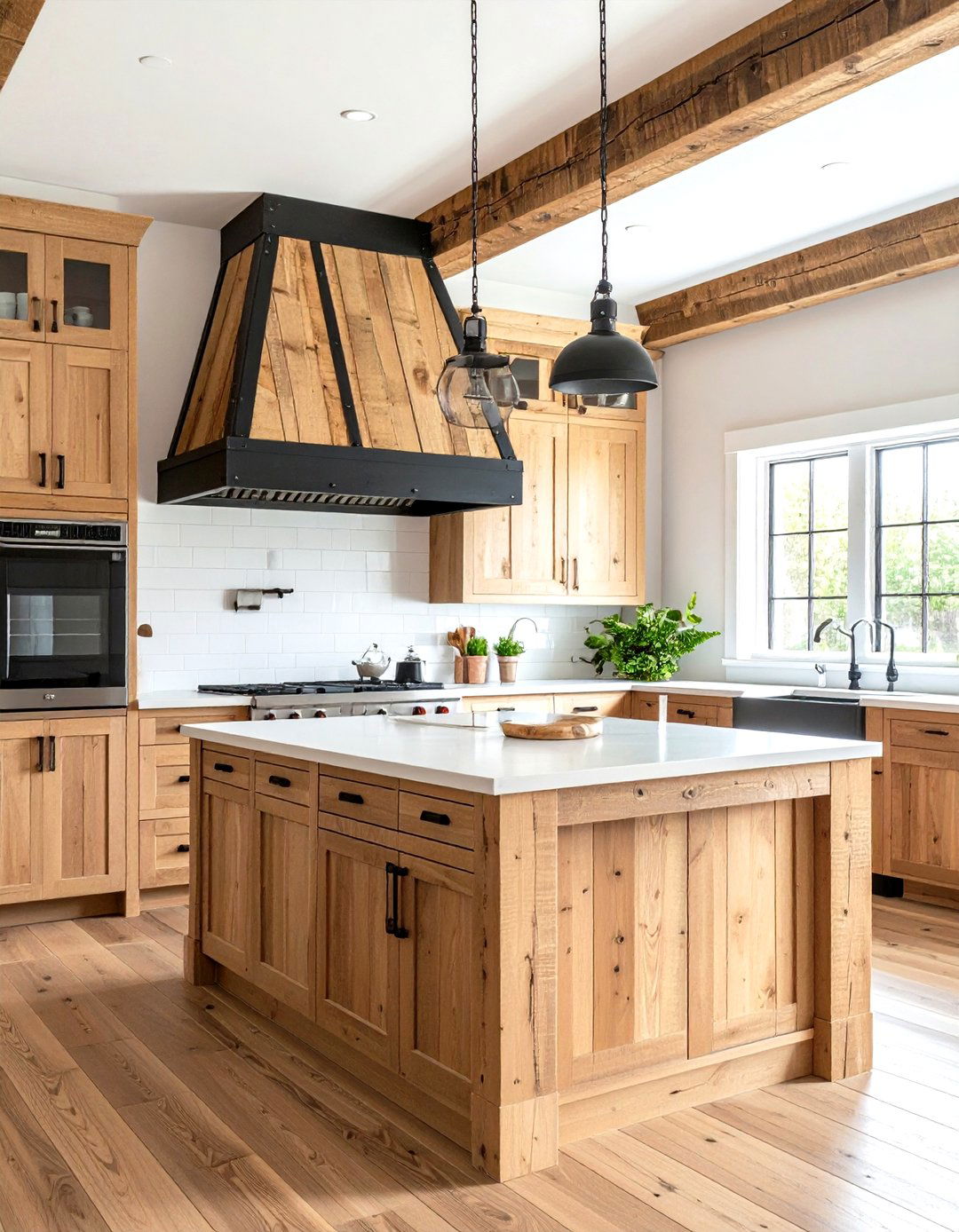
Bringing weathered barn boards into the kitchen through a reclaimed-wood range hood instantly writes a story of age and authenticity. Akicon’s handcrafted hood kit uses North American salvaged planks pre-cut for easy assembly, showcasing saw marks and rich patinas that manufactured wood can’t mimic. Rustic Kitchen & Bath echoes the appeal, noting that pairing reclaimed wood with black iron strapping reinforces farmhouse character while still housing a professional-grade liner. Finish the hood in low-VOC clear matte to keep the grain visible and mount it over rough-edge stone tiles for depth and tactile contrast in open-concept country homes everywhere.
12. Industrial Blackened Steel Range Hood
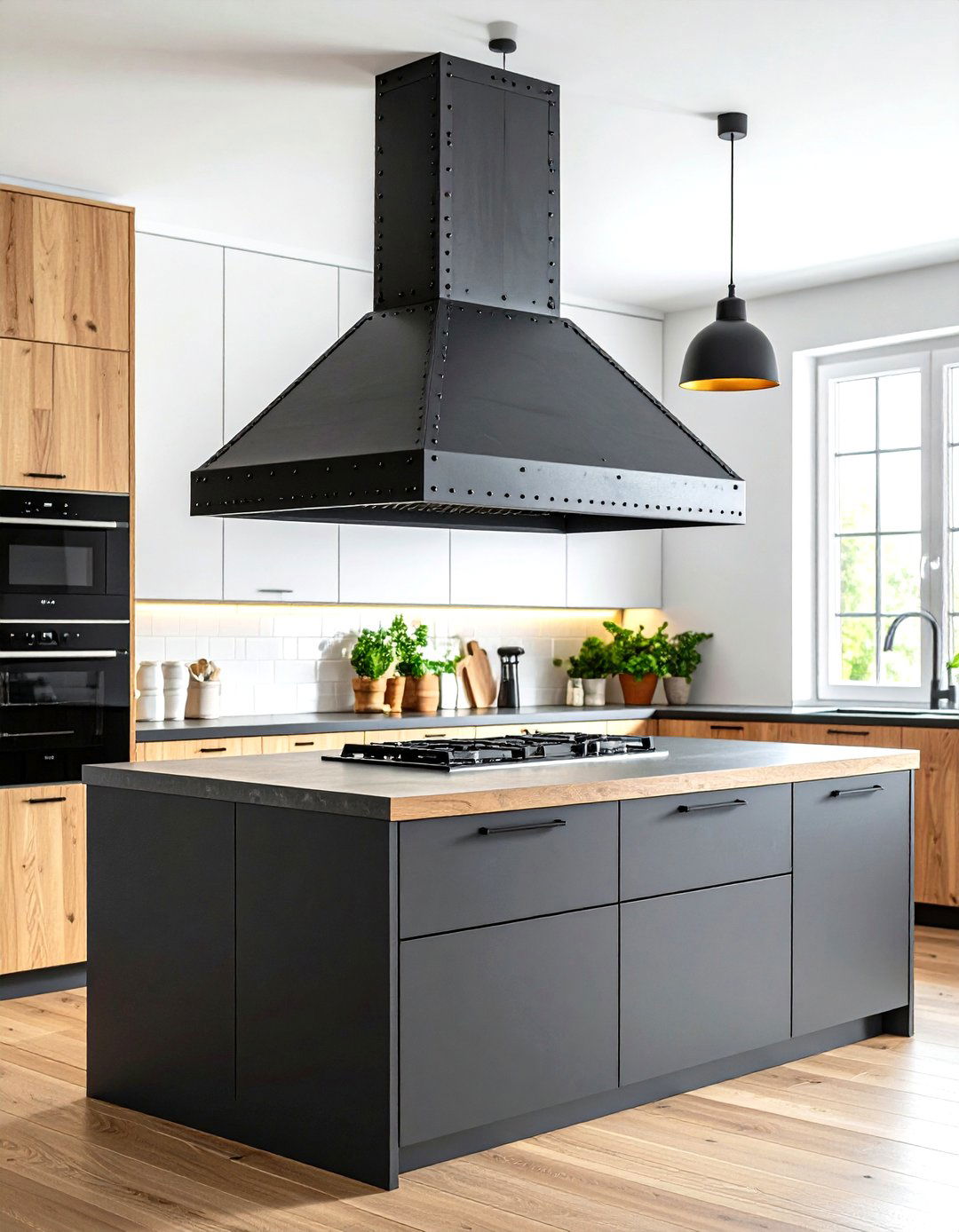
Unlike rustic planks or painted plaster, a blackened-steel range hood channels urban loft energy with its smoky finish and crisp riveted seams. Porter Barn Wood showcases custom fabricated hoods where hot-rolled steel panels are waxed to a deep charcoal sheen, offering both durability and a dramatic backdrop for stainless appliances. Because steel is magnet-friendly, you can attach slim magnetic spice rails or clip-on task lights without drilling. Balance the industrial edge by setting the hood against whitewashed brick and adding warm walnut shelves nearby, achieving a chic contrast of raw and refined that suits eclectic city lofts perfectly today.
13. Mixed-Material Range Hood Fusion
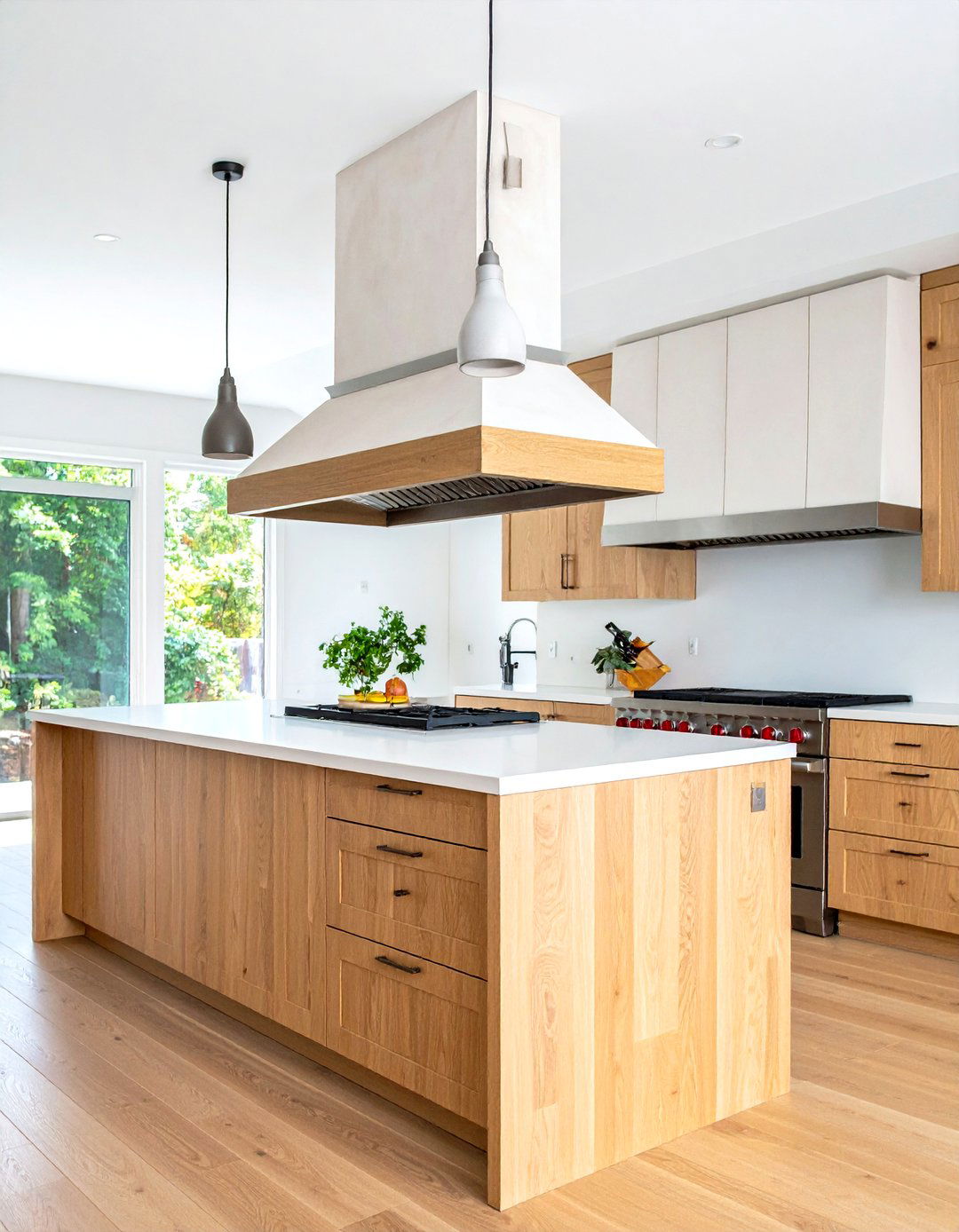
Moreover, combining two materials—say, plaster above and ribbed white oak below—creates a bespoke range hood that reads like furniture rather than appliance. Architectural Digest features examples where designers introduce slim metal reveals between materials to keep the junction crisp and intentional. Adding contrasting textures lets you echo finish combinations already present in the room, such as marble veining against oak flooring, tying the palette together. For longevity, specify that wood portions attach to a removable frame so you can refinish them without uninstalling the fan motor, ensuring the hood evolves alongside future kitchen refreshes with ease and minimal cost.
14. Minimalist Box Range Hood
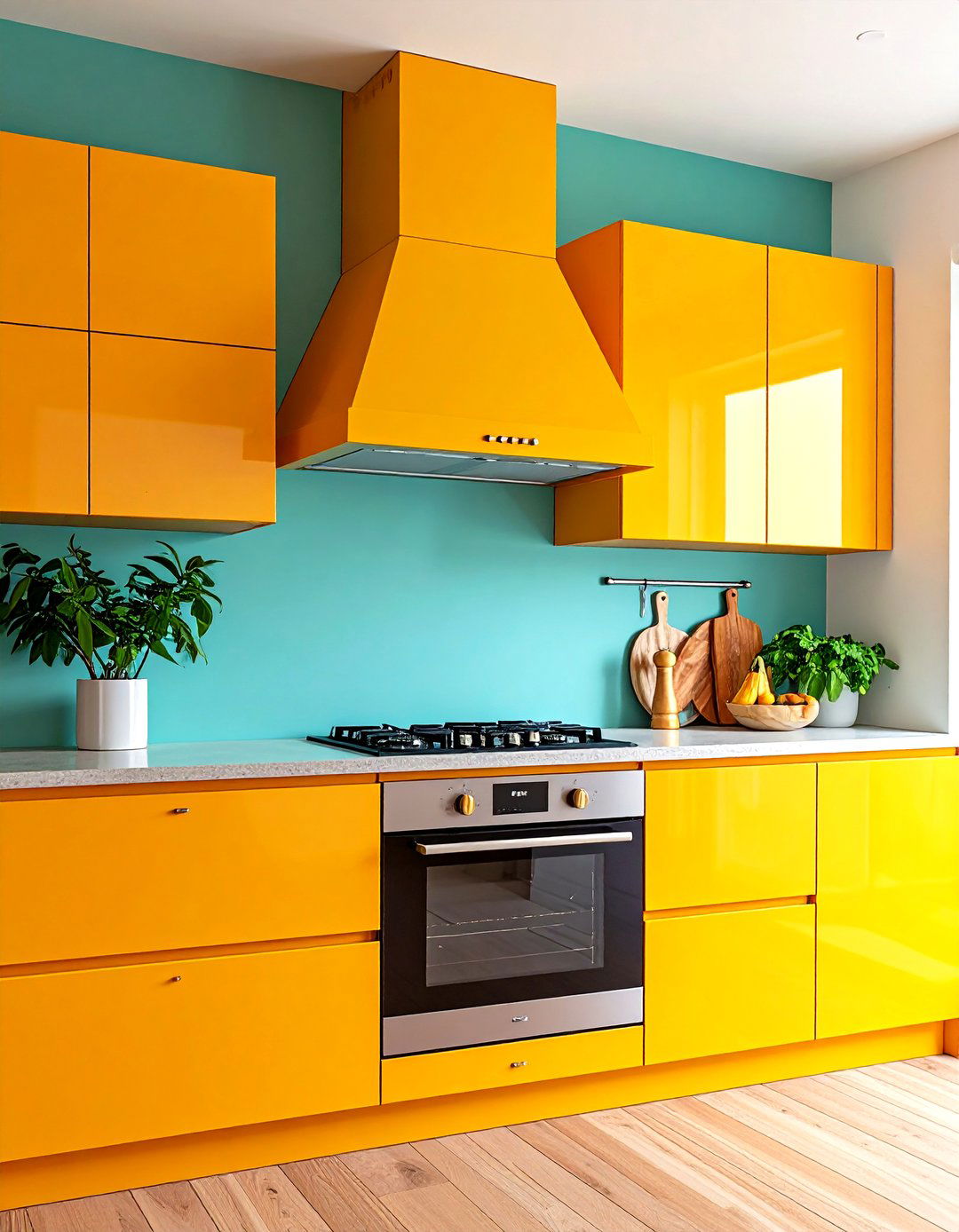
To achieve true minimalism, many architects install a perfectly square box range hood, free of ornament and disguised by the same paint finish as the walls. Architectural Digest notes that the purity of the silhouette allows marble backsplashes and flush-inset cabinets to shine, while the hood does its job quietly in the background. Opt for a recirculating insert with charcoal filters if exterior venting lines would break the pristine look, and conceal touch controls along the underside. Pair the box with linear LED strips recessed into the ceiling for unobtrusive task illumination that keeps visual clutter to near-zero levels.
15. Barrel-Style Curved Range Hood
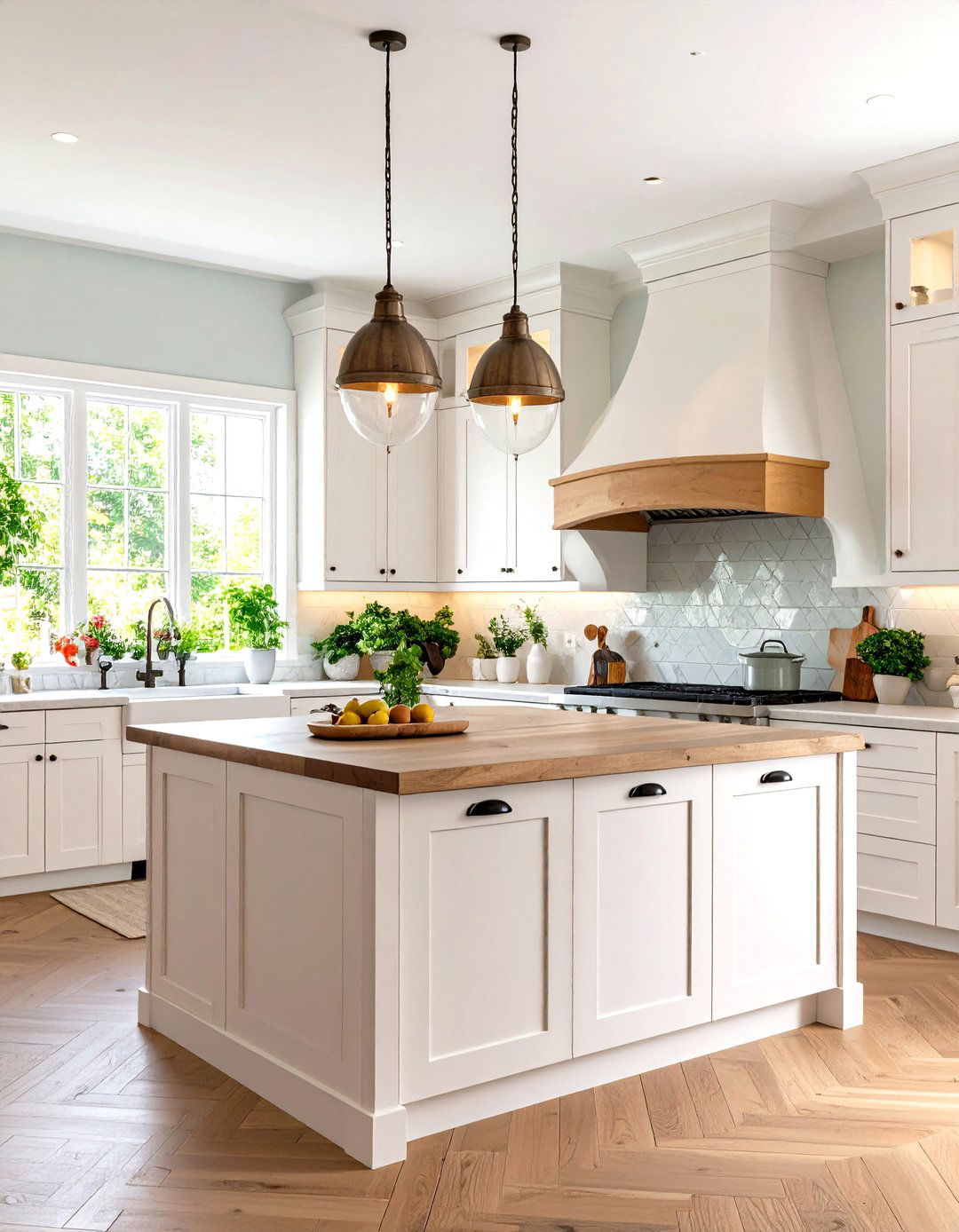
Surprisingly, a soft barrel-shaped range hood can ease the rectilinear rigidity of shaker cabinets, introducing gentle movement above the stove. Architectural Digest identifies curved hoods as a growing favorite in bespoke European kitchens, often finished in plaster or brushed metal for subtle sheen. Fabricators form the radius with bent plywood ribs, then skin it in flexible MDF before applying your chosen veneer or plaster, ensuring a perfectly smooth arc. Echo the curve with rounded cabinet pulls or a bullnose countertop profile, and you’ll foster a calm, cohesive atmosphere that invites lingering conversation during relaxed weekend pasta cooking sessions today.
16. Island Chimney Range Hood
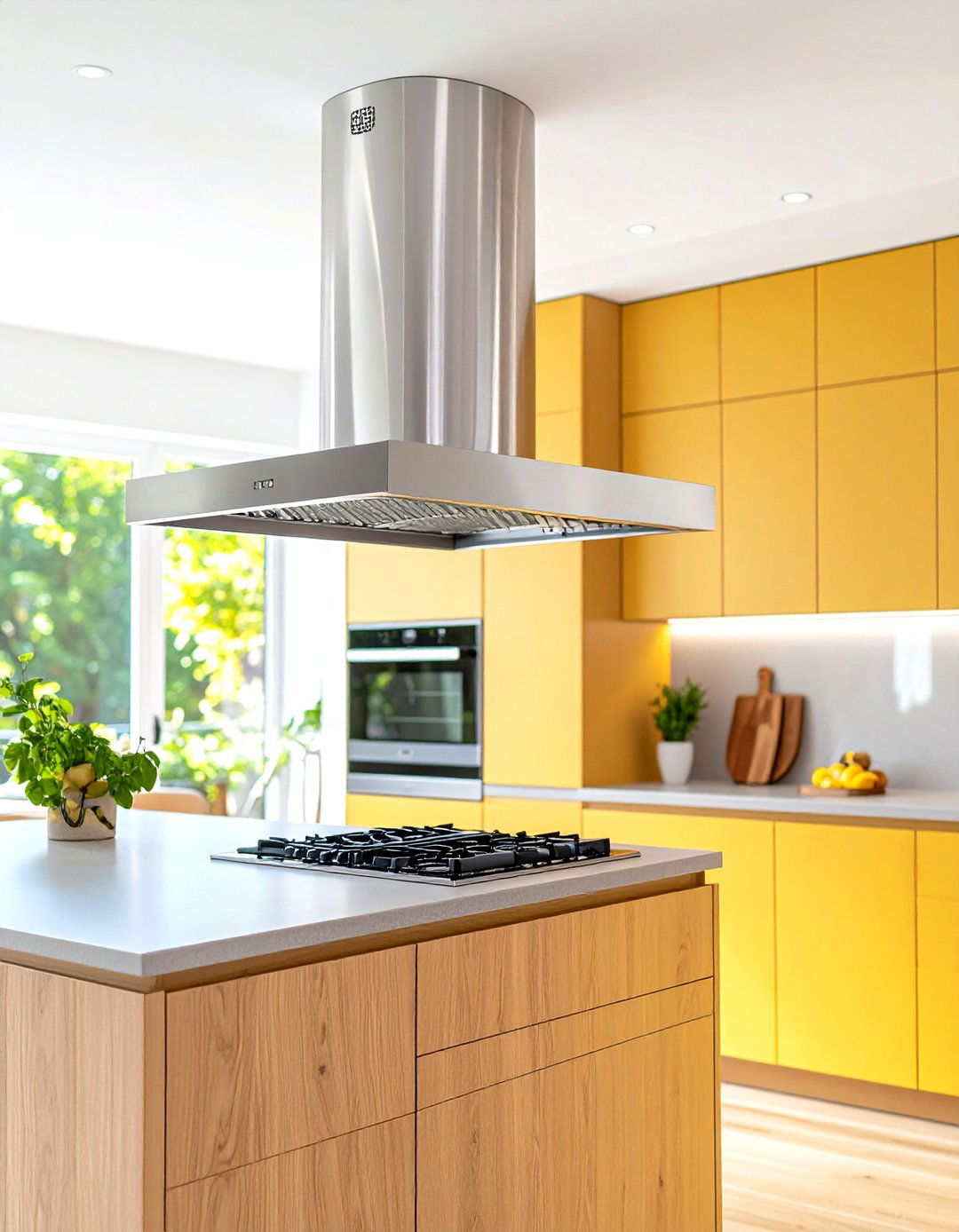
When your cooktop sits on an island, a dramatic chimney-style range hood can anchor the entire floor plan like a sculptural column. Martha Stewart Living showcases oversize metal chimneys rising from islands, calling them “architectural exclamation points” that balance tall cabinetry on the perimeter walls. To keep sight-lines open, choose a tapered silhouette narrower at the base than the canopy and suspend it with sleek stainless duct covers finished to ceiling height. Install a 900-CFM motor to compensate for cross-drafts common in open rooms, and add perimeter lighting to highlight the hood’s shape after dark, making dinner feel theatrical.
17. Range Hood with Built-In Shelf

Looking for functional flair? Integrate a narrow display shelf just below the hood’s lower trim to hold olive-oil bottles, small art, or a collection of copper utensils. Pinterest inspiration galleries reveal that a three-inch-deep oak ledge doesn’t compromise airflow when paired with a powerful insert and allows cooks to grab seasoning without crossing the kitchen. Be sure to finish the shelf underside in heat-resistant lacquer and add an LED strip tucked against the back wall to back-light displayed items. The result feels part pot-rack, part artwork, and entirely practical, elevating everyday cooking into a curated chef’s vignette each day.
18. Angled Contemporary Range Hood
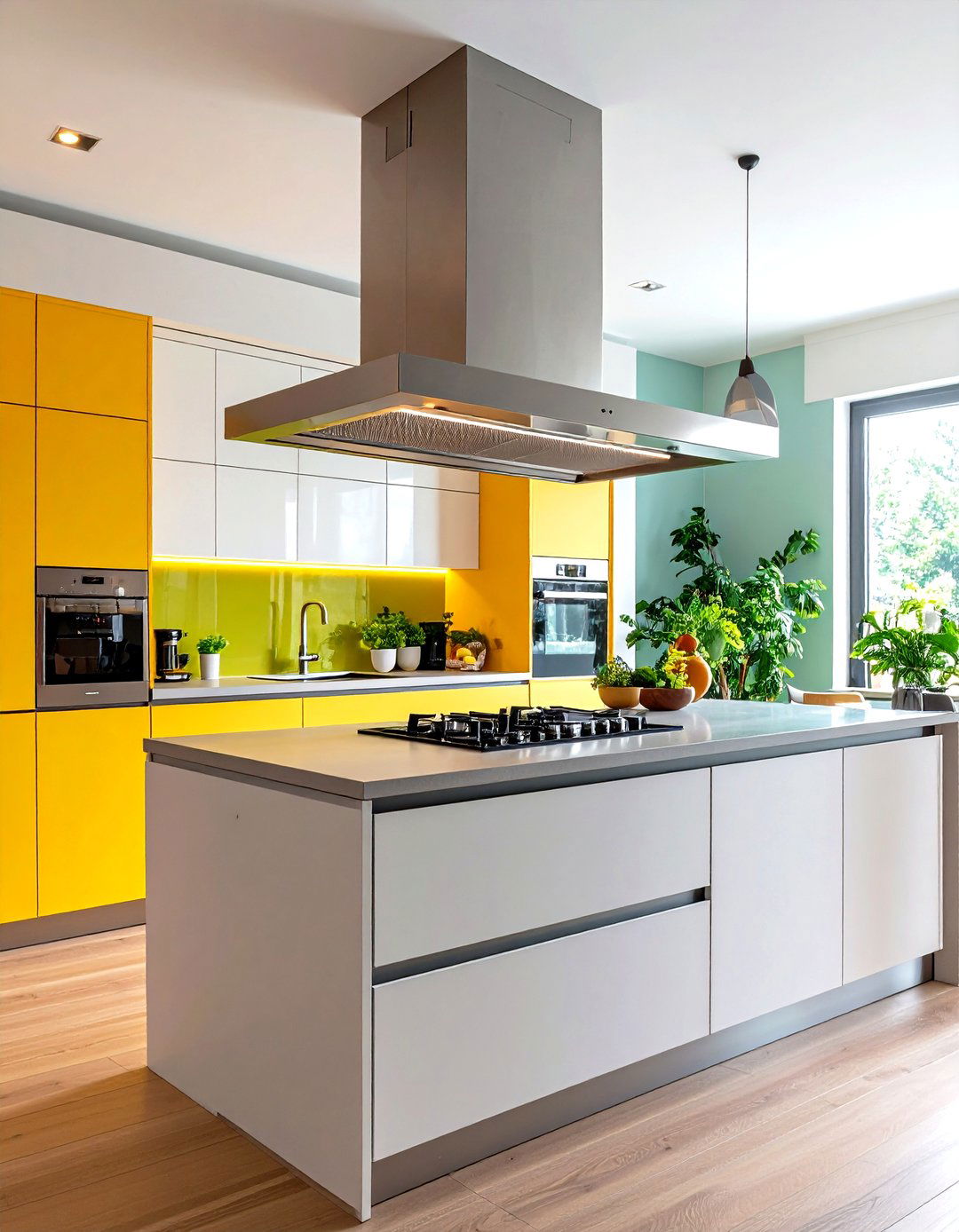
Despite the popularity of curves, sharply angled range hoods remain staples in ultra-modern kitchens, echoing the facets of geometric pendant lights and waterfall islands. Architectural Digest’s roundup shows designers crafting hoods with front faces slanted at 45 degrees, a move that improves head clearance while looking avant-garde. Powder-coated aluminum panels keep weight low, while hidden seams and push-button panels maintain the crisp look. Finish the edges in contrasting metal—matte nickel against black, for instance—to underline the geometry. Pair with handle-less cabinets and finger-pull drawers for a cohesive, math-inspired aesthetic that delights lovers of precision-built contemporary interiors and gadgets alike.
19. Vintage-Inspired Curved Range Hood
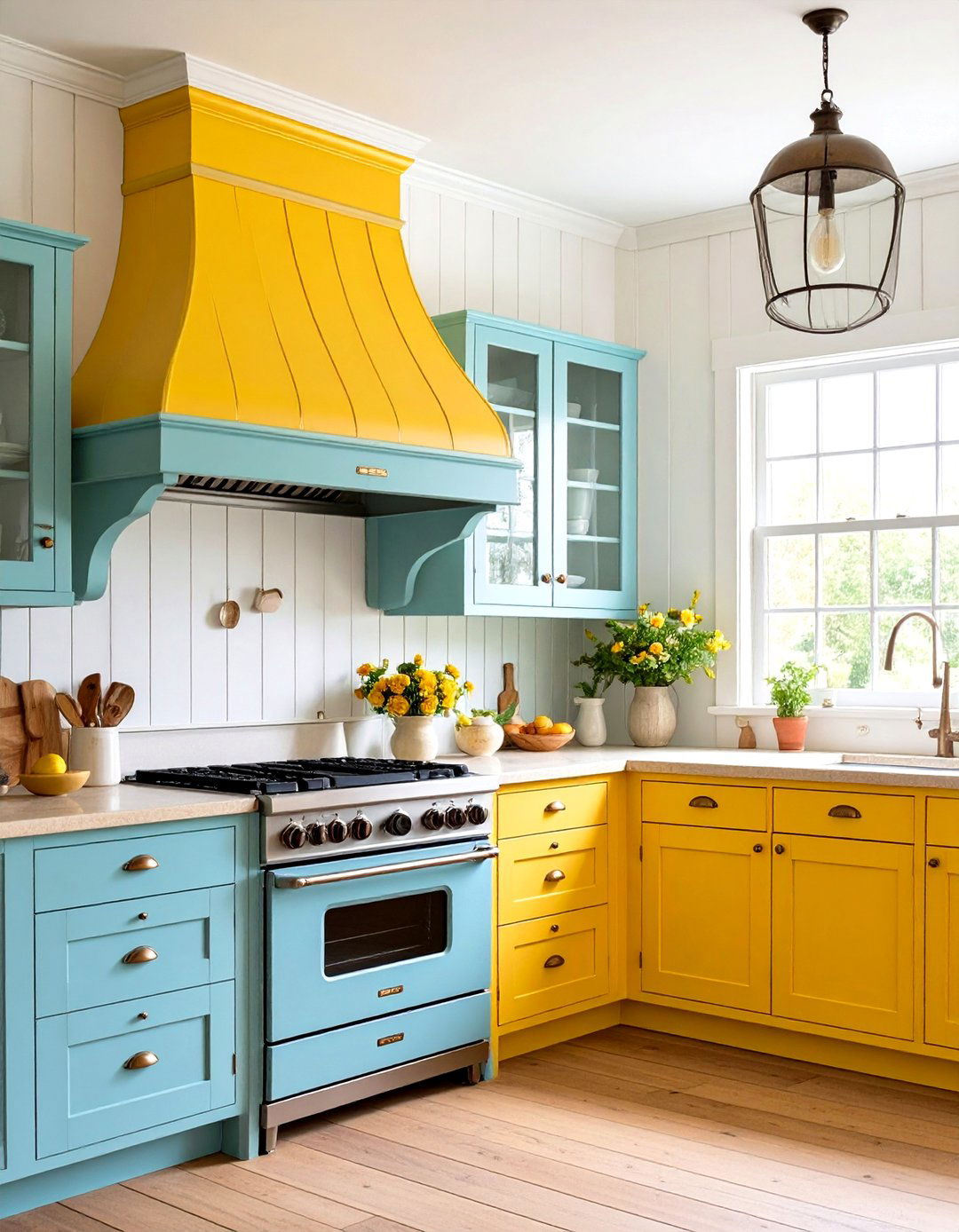
As retro styles return, a curved canopy clad in beadboard or lightly distressed paint channels the charm of a 1950s cottage kitchen. The Spruce recommends pairing vintage hoods with checkerboard floors and unlacquered brass hardware for authenticity that still feels livable. Add a period-correct chrome clock to the center band, wire in an analog fan switch, and complement with pastel appliances for full nostalgic effect. To modernize performance, tuck a quiet 400-CFM insert inside and route ductwork through existing soffits, preserving historic ceilings. The result is past meets present in delicious harmony, sure to charm guests at brunch time.
20. Integrated Smart Range Hood with Touch Controls
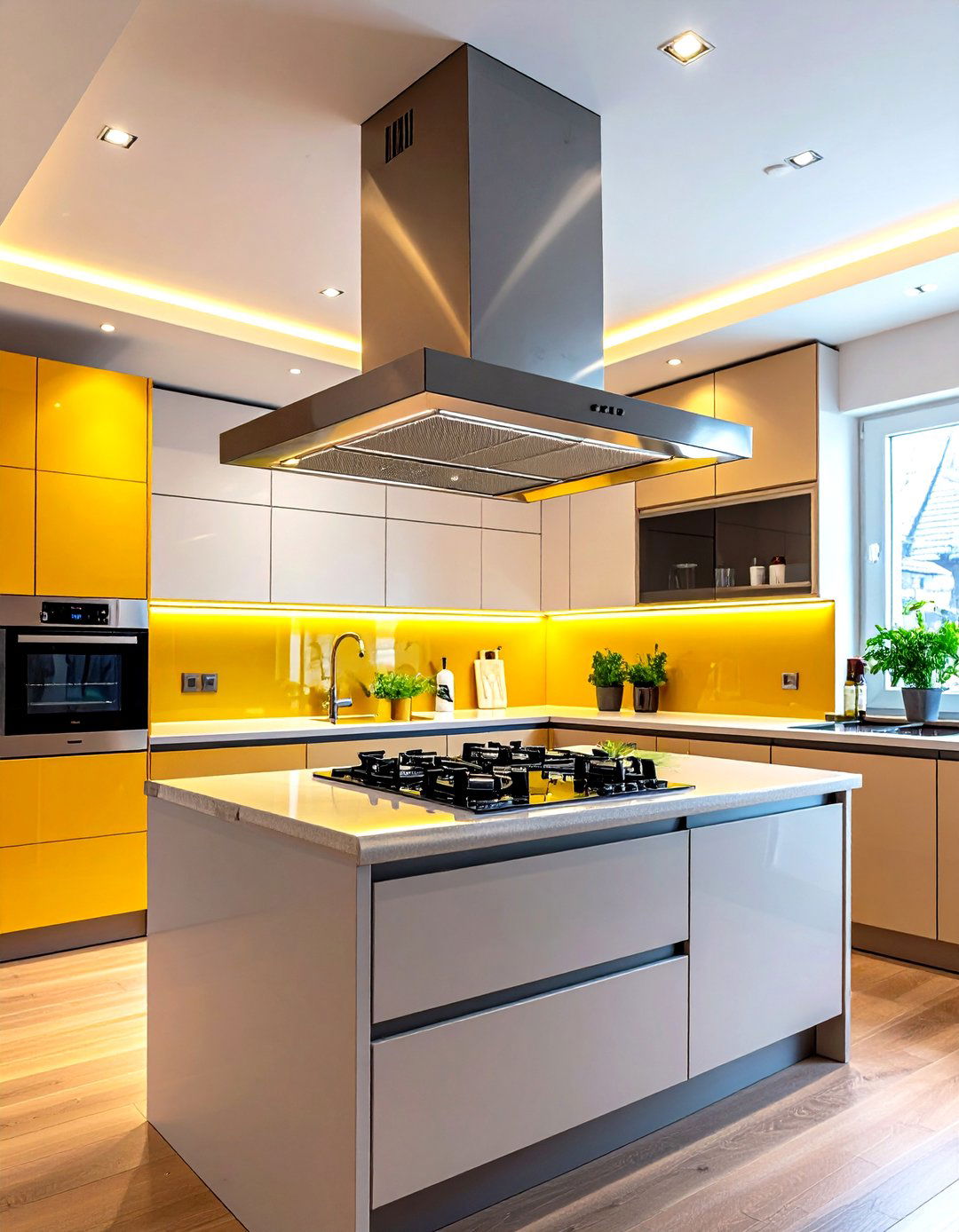
From automatic fan speed adjustment to app-based filter reminders, smart range hoods are quickly becoming the brains of the cooking zone. Whirlpool’s feature list includes concealed touch panels that light up only when pressed, keeping grease off buttons and simplifying cleanup. Some premium models even sync with Wi-Fi to power on when the cooktop heats, integrating with voice assistants for hands-free commands. Hide the wiring behind a panel-ready face so the technology disappears until needed, and choose stainless or matte black to match other smart appliances. High-tech, low-profile, and supremely convenient—that’s the future of ventilation for busy modern households.
Conclusion
Conclusion:
To wrap things up, today’s range hood is far more than a smoke extractor. Whether you lean rustic with reclaimed beams or ultra-sleek with flush ceiling grilles, the vent can establish style, improve air quality, and even flaunt cutting-edge intelligence. Use the ideas above as a choose-your-own design menu: mix materials, play with curves, or disappear the whole appliance behind cabinetry. With the right insert sizing and thoughtful finishes, any of these twenty concepts will pull their weight in both performance and personality.


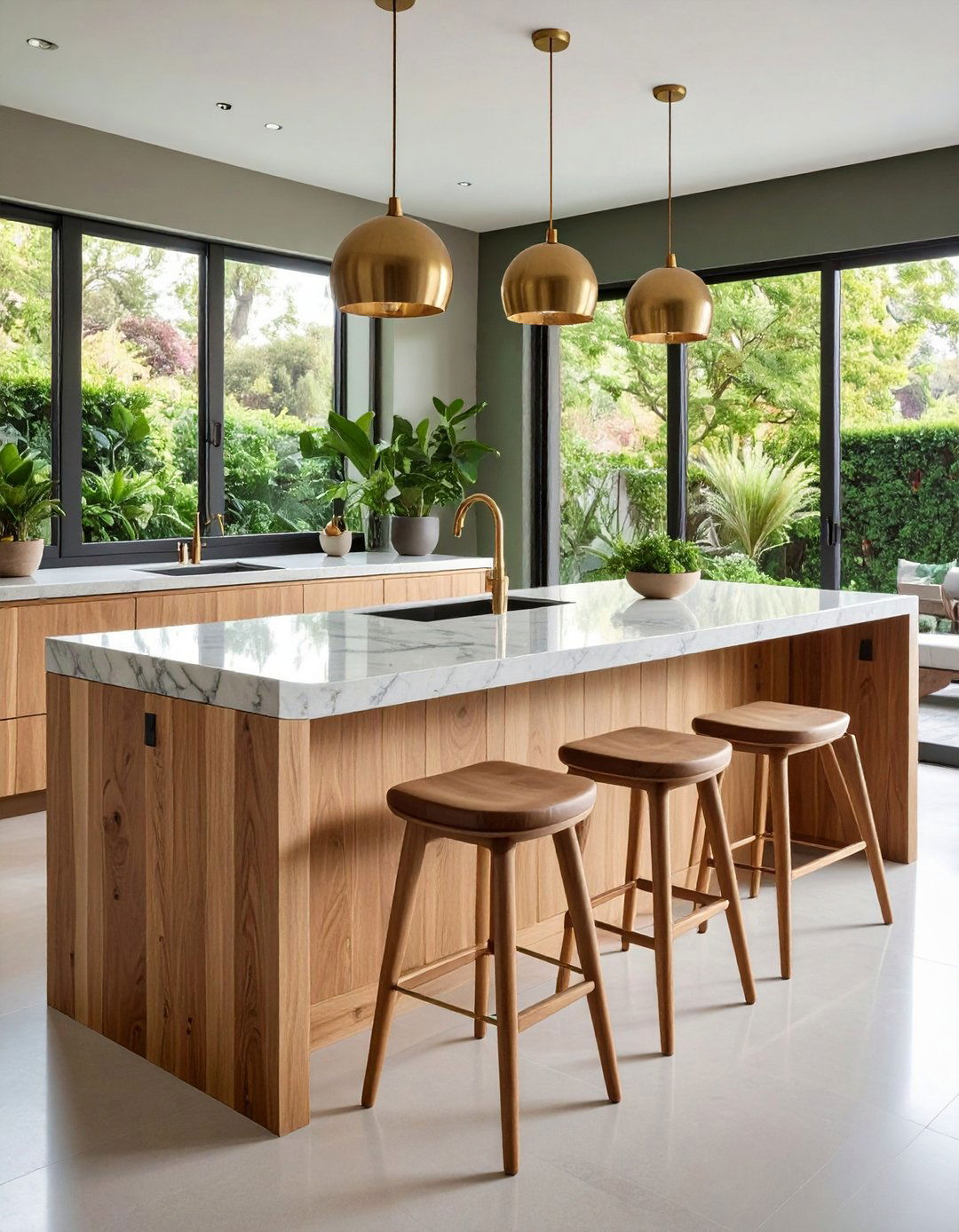
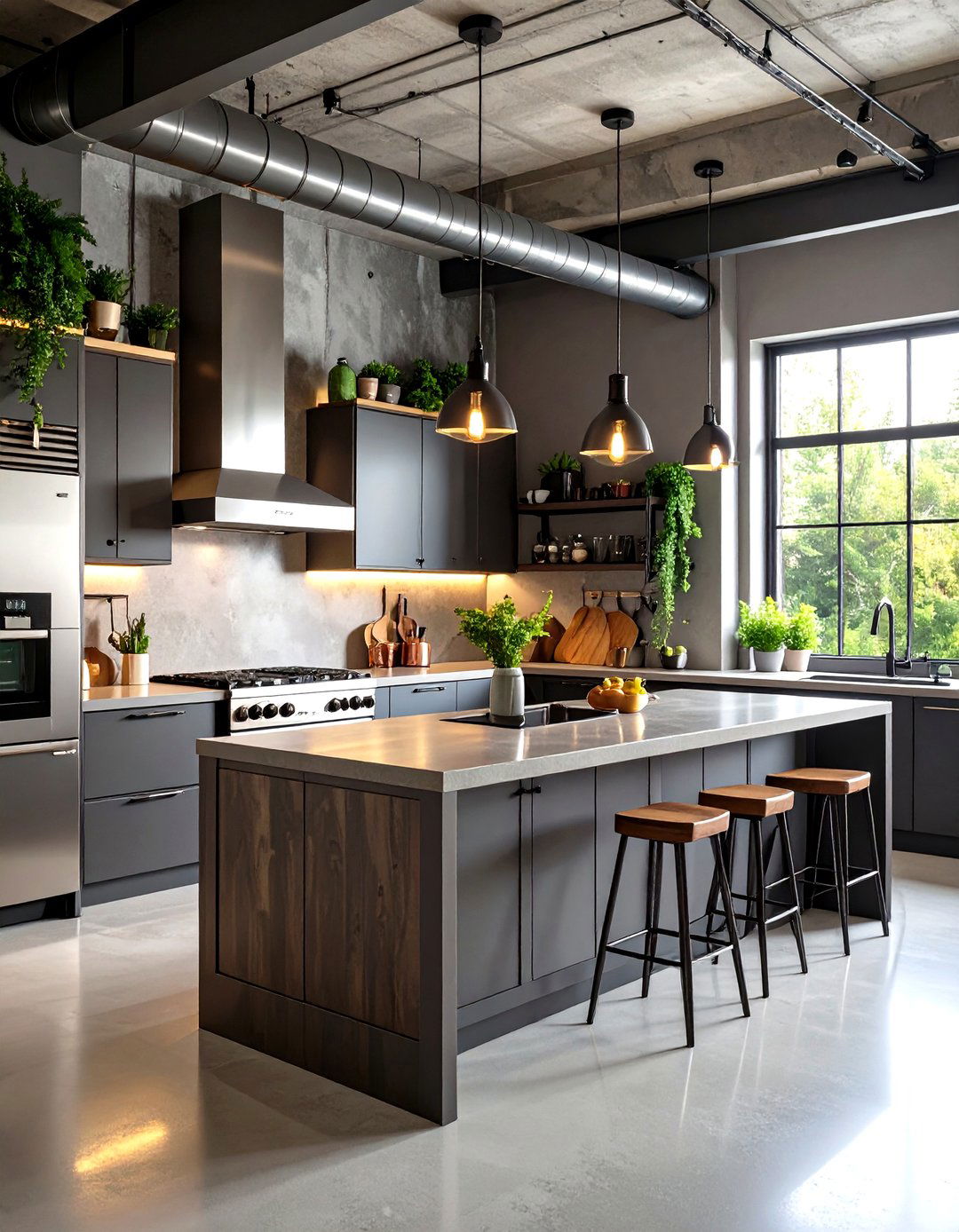
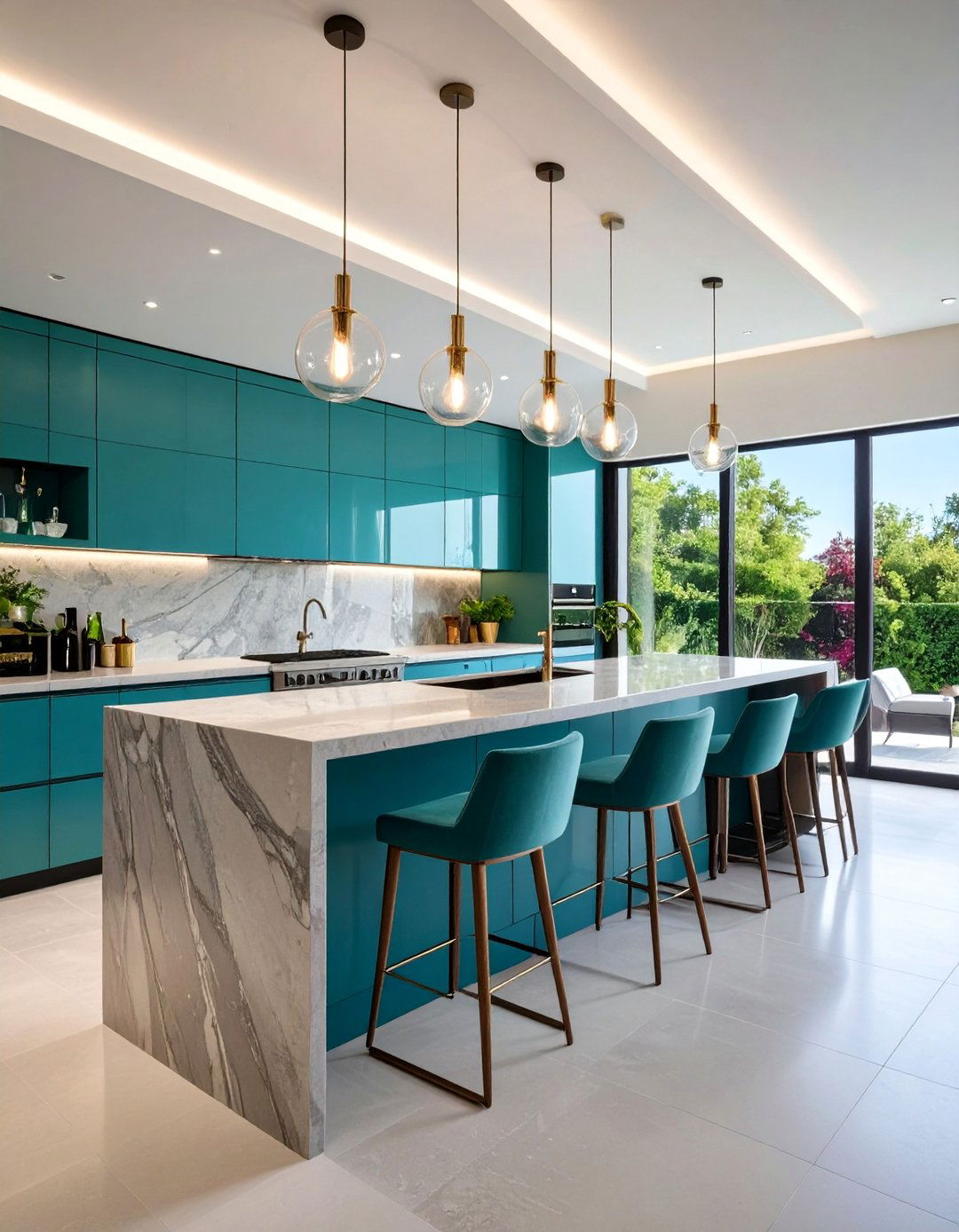


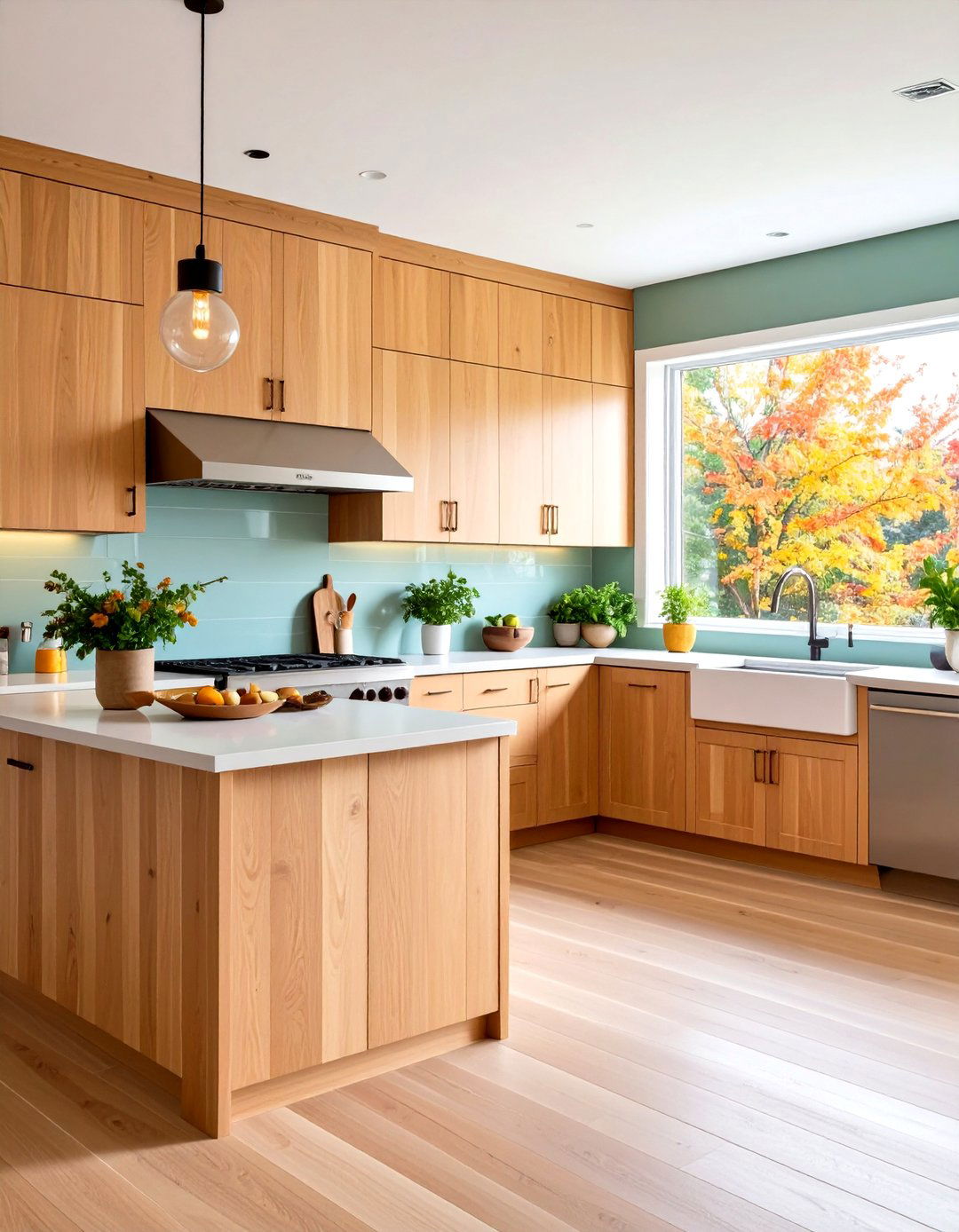
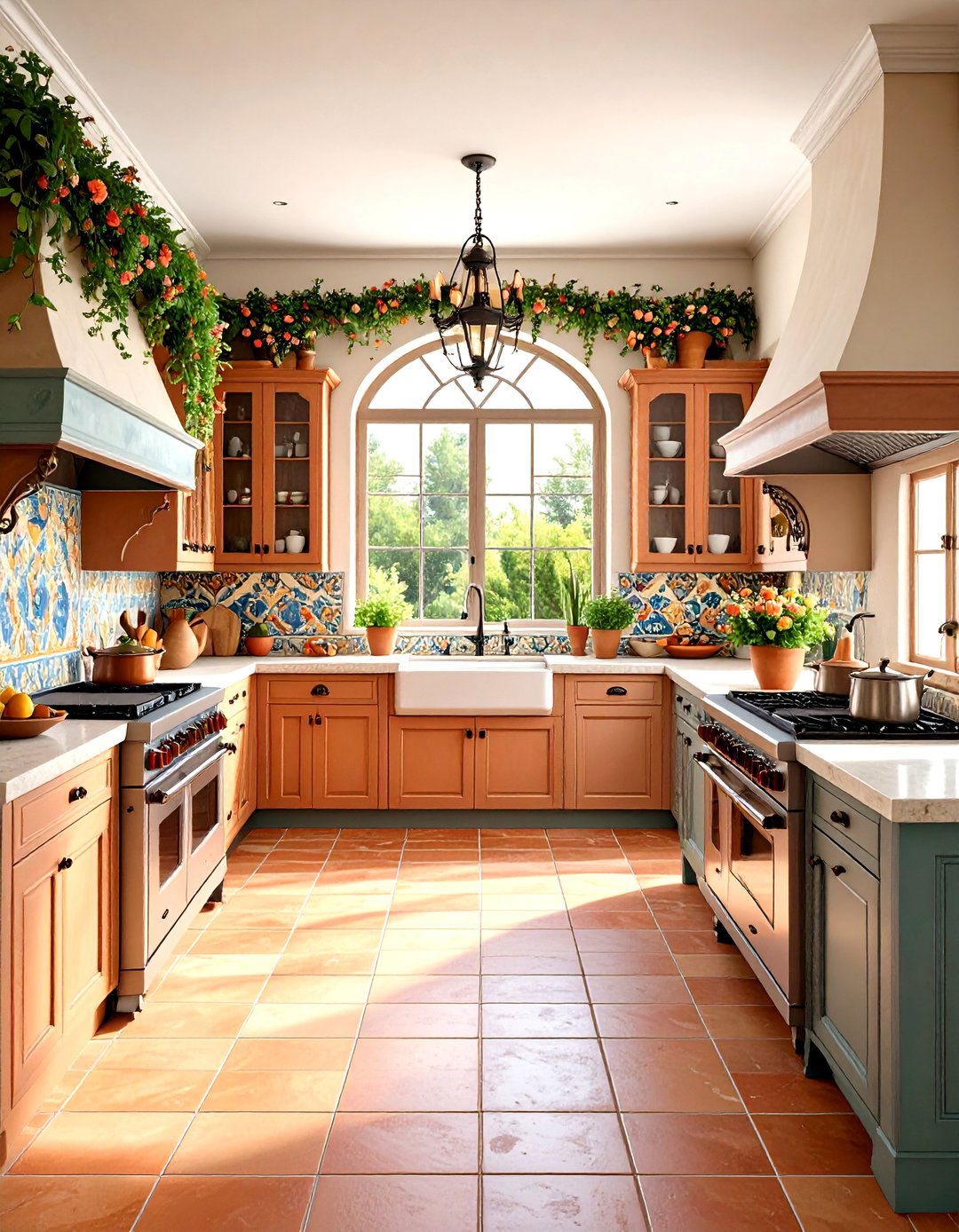

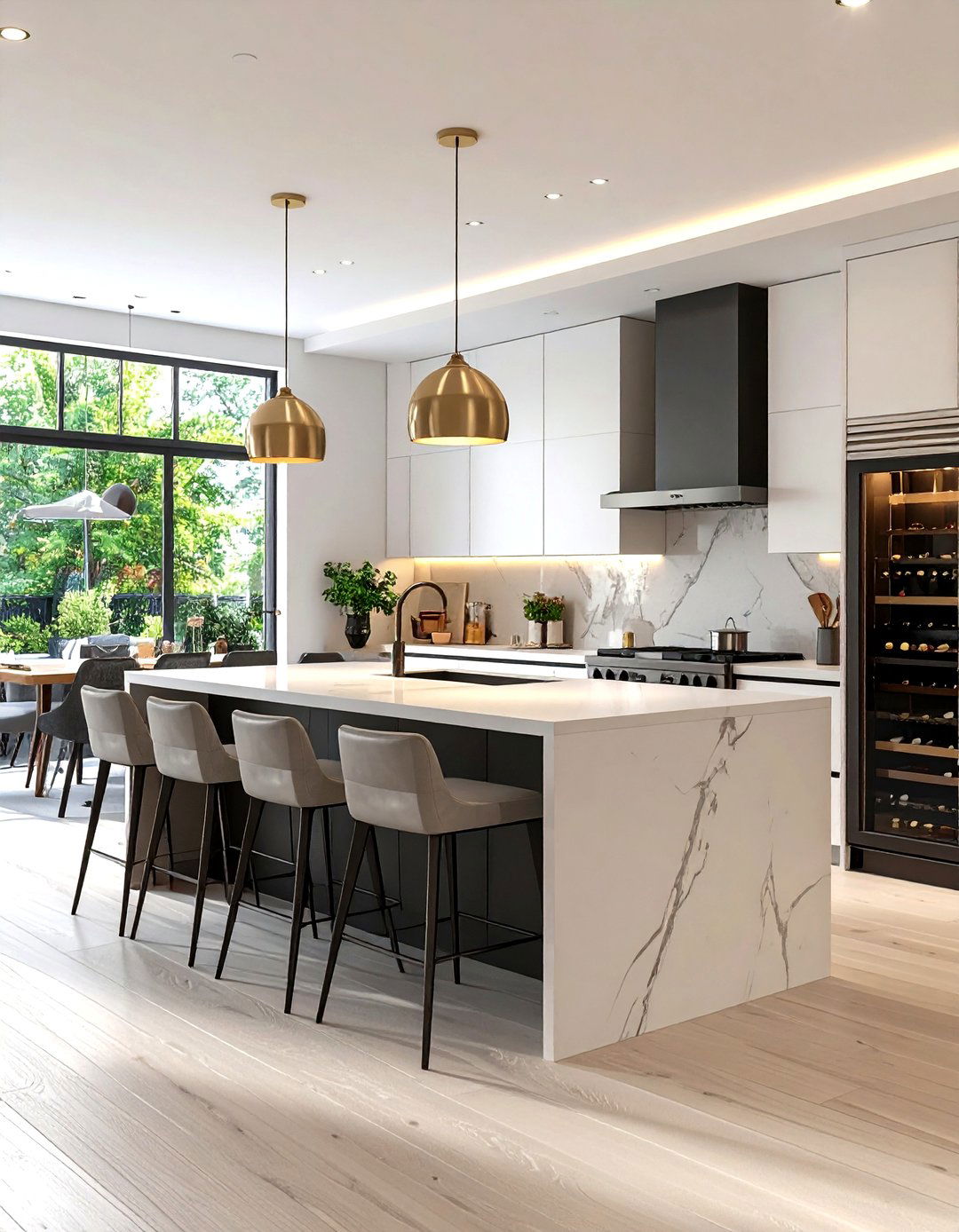
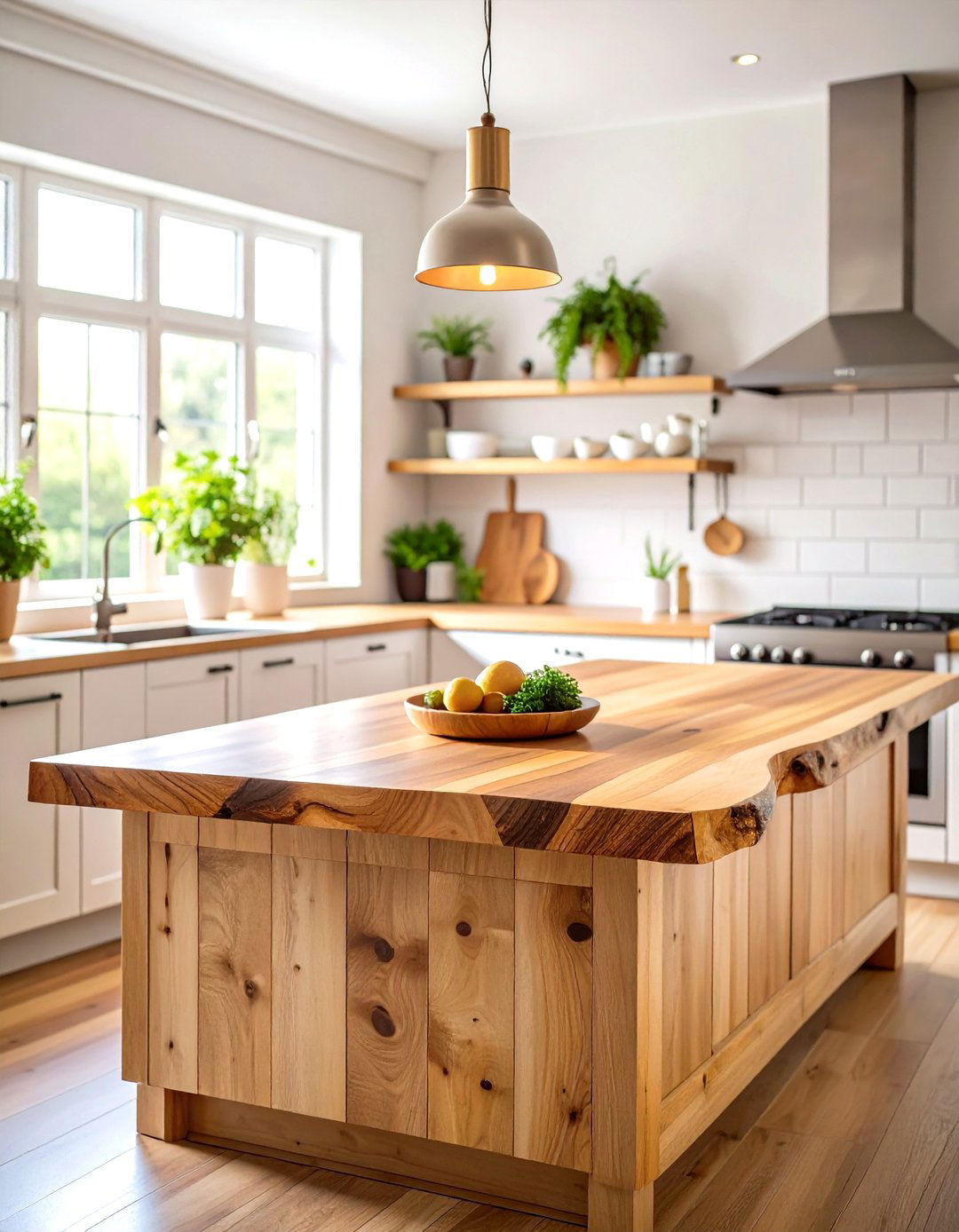
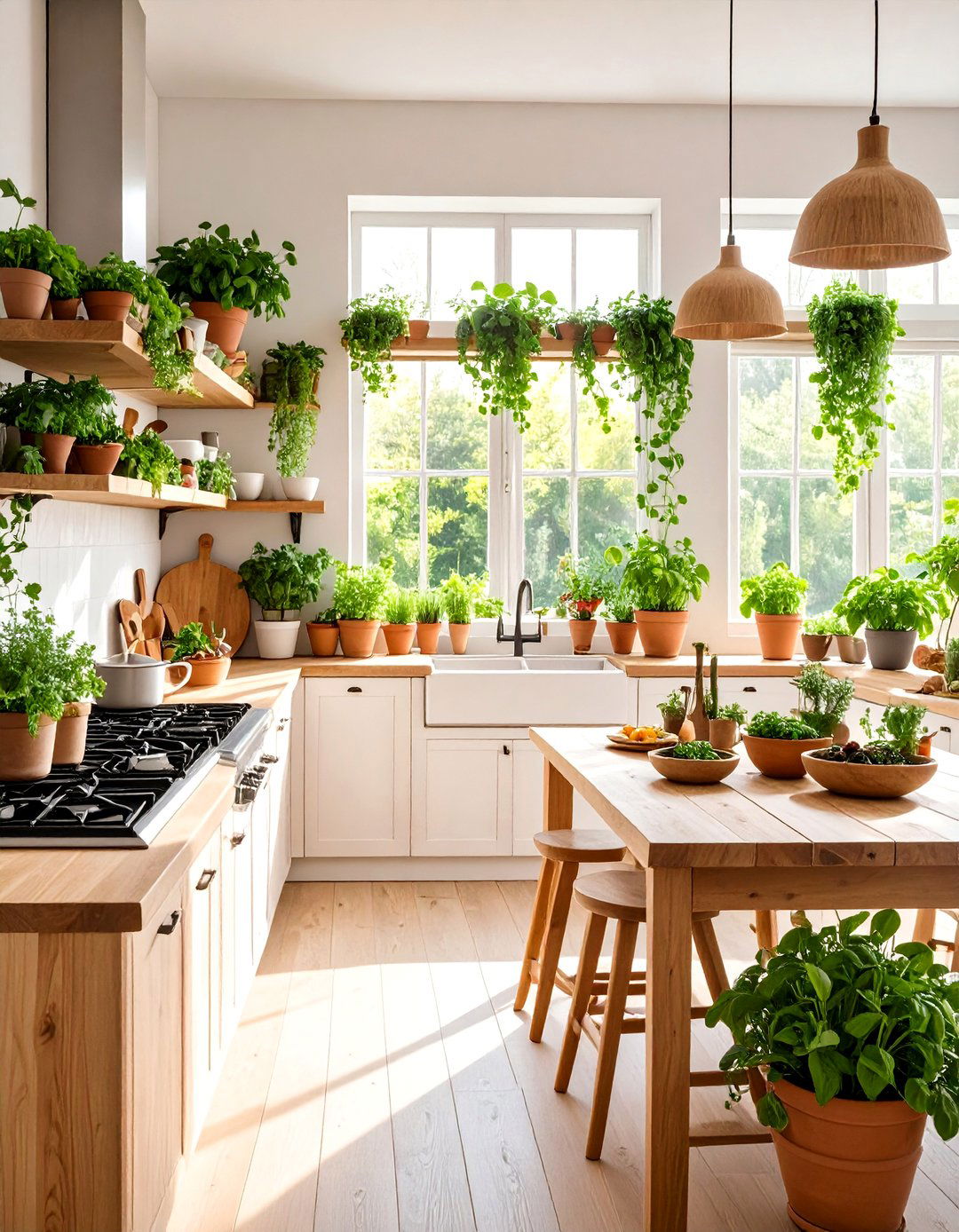
Leave a Reply